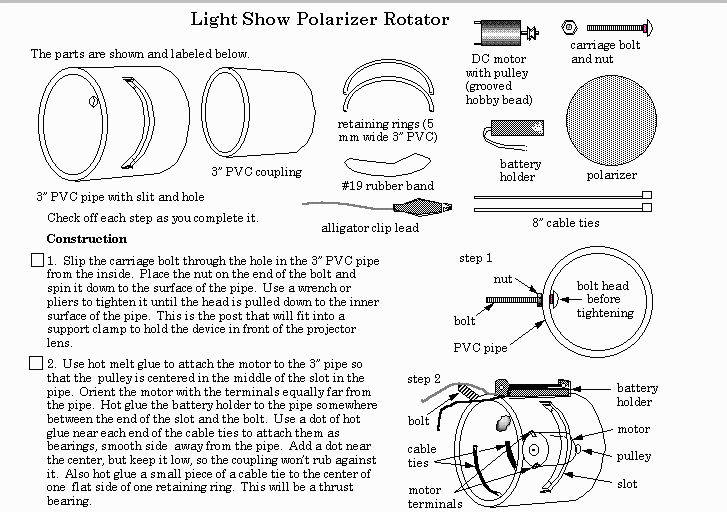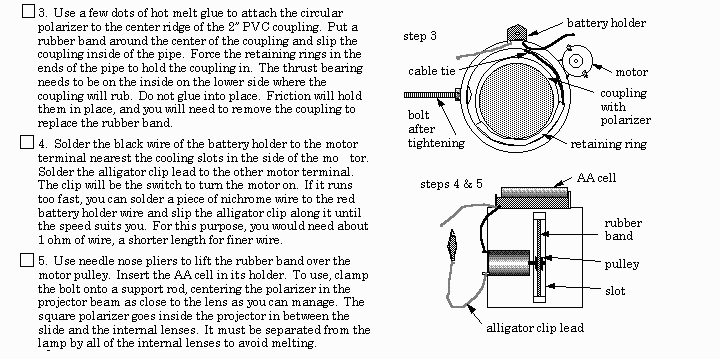

Lecture Demonstration Apparatus
Apparatus Title: Light Show Polarizer Rotator
Abstract: Colors produced by thin birefringent materials between polarizers are especially vivid when one polarizer is rotated so that each area is flipped between complementary colors with timing approximating the persistence of vision (even better with loud music). This device provides a low cost way to produce the slow rotation required.
Description of Apparatus:
Thin birefringent materials between polarizers can produce very pretty colors. And the colors change to their complements when the permitted directions of the polarizers are changed from parallel to perpendicular. The effect, widely used to enhance contrast in the study thin sections in biological and geological laboratories, is well known but rarely explained.
The beautiful color effects really grab students' attention. The explanation of these colors is not easy, but students' fascination with the the beauty and mystery of the effect provides strong motivation for wading through it. In the process, students must return to every aspect of color vision, interference, and vector addition. The rather lengthy explanation can be found elsewhere and will not be repeated here.[1,2,3,4]
A "light show" projecting student-made slides accompanied by loud music is an extremely popular climax to this study.[2,3] The colors are especially vivid when one polarizer is rotated so that each area is flipped between complementary colors with timing approximating persistence of vision. Since this also approximates musical beat time, the effect is further enhanced by adding music with a strong beat.
The "light show" arrangement is inexpensive and easy to set up with one exception, that being a means to rotate one polarizer in front of the projector lens at about one revolution per second. This rate works well because persistence of vision is about a quarter of a second and there is a color change for every one quarter of a turn of the polarizer. It used to be easy to find discarded 78 rpm record players that served the purpose nicely, but the remaining ones tend to be regarded now as antiques, rather than as junk. Garage sale kitchen mixers are a possibility, but are often intrusively noisy. I was forced into the device presented here by the time and cost restraints of PTRA workshop funding.
I was trying to make do with a small leftover supply of Polaroid film while trying to find about 25 inexpensive rotators for the participants. The quantity needed made garage sale rummaging impractical, so I shifted to PVC pipe and rubber band mode.
I considered using a belt drive around the circumference of the polarizer as a speed reducer for a cheap DC motor. Then I realized that this offered an additional advantage. A polarizer driven by a central axle needs to be at least 15 cm in diameter in order to cover the projector lens, but a circumferentially driven polarizer need only be as large as the lens, about 6 cm in diameter. That would make my Polaroid film go a lot farther.
The design shown on the following page was the last of several prototypes. It was used for the workshop and has proven to be successful. The polarizer is attached to a PVC coupling which rotates within a larger piece of PVC pipe. Friction is minimized by nylon bearings (cable ties) glued to the interior of the pipe. A rubber band belt passes around the coupling and through a slit in the pipe to a small pulley made from a hobby bead on the axle of a cheap DC motor. A bolt through the pipe provides a means of clamping the device to a vertical laboratory support pole.
The motor rotates the polarizer at an appropriate rate with an input of about 1 volt. Driven directly with a 1.5 volt dry cell, it runs just a bit fast. To slow it down, a small resistor can be used, preferably a variable one that can be adjusted to compensate for an aging battery or to better match the beat of the music. The resistor can be a potentiometer or a length of high resistance wire with an alligator clip slider. An even better solution is a low voltage variable power supply, which most physics teachers have on their shelves.


References
1..Bauman, Robert, and Moore, Dennis, "Classical Demonstrations of Polarization." The Physics Teacher, 18, 214 (March 1980)
2. Franklin, Bill, "The Psychedelic Student-Getter." The Physics Teacher, 7, 227 (April 1969)
3. Franklin, Bill, Teaching About Color and Color Vision, a PTRA Workshop Manual, AAPT, College Park, MD, 1996
4. Wood, Elizabeth, Crystals and Light, Van Nostrand, Princeton, NJ, 1964